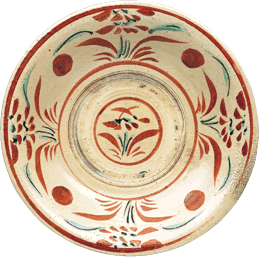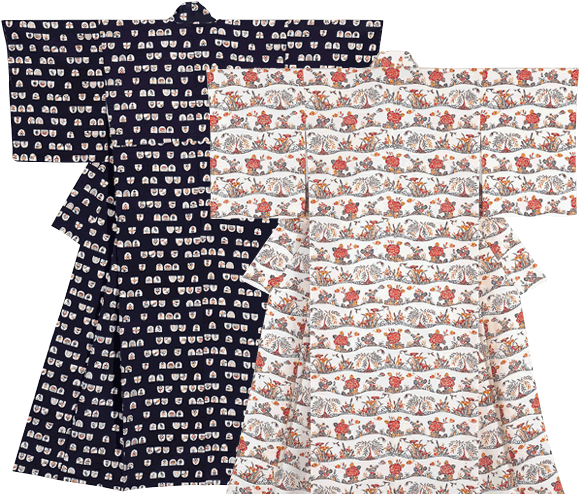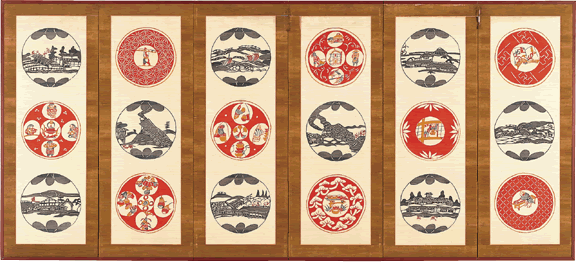

Dish Floral design
By Serizawa Keisuke
c. 1940
With the support of Shiga Prefecture, Shiga Prefectural Board of Education, Tohoku Fukushi University Serizawa Keisuke Art and Craft Museum, Shizuoka City Serizawa Keisuke Art Museum, NHK Broadcasting Otsu Office, and Biwako Broadcasting Co., Ltd.
![Aka-e Modoki [Enameling-Motif Samples]](image/01b.gif)
![Aka-e Modoki [Enameling-Motif Samples]](image/01c.gif)
Aka-e Modoki [Enameling-Motif Samples]
Dated 1943
 |
|
|
Kimono Small flowers in fingernail shapes circa 1970 |
 Kimono Wild flowers, dated 1959 |

Six-leaf Screen Kilns of northeastern Japan
(with designs reminiscent of aka-e ware), dated 1938
I once saw Chinese Song-dynasty aka-e (literally, "red painting," overglaze enamel ceramic) and was amazed. The red flower petals on the dishes looked like gold fishes dancing on the water's surface, and the slip, so white and pure, touched my heart. When I saw Serizawa's aka-e ceramic ware, his works struck me as those of a reincarnation of a Song aka-e master. The swaying lines of his trees and grass touched my heart in the same way as the Song examples. They made me realize that many of Serizawa's other designs recall aka-e patterns and motifs. These designs, taken from his daily life, when arranged in circles and squares spontaneously begin to look like aka-e. His energetic brushstrokes, his charming miniature floral motifs, and his use of red and green appear here and there on his kimono and folding screens.
Serizawa began producing aka-e ceramics before World War II, using Okinawan Tsuboya-ware pottery materials and having the Mingei Undô (Folkcraft Movement) ceramicist Hamada Shôji (1894-1978) help him build a kiln. The pieces from that time included many plates, large bowls, and incense containers painted with willows. I am sure those who acquired such fine works were more than pleased. Unfortunately, the kiln and materials from this time turned into ashes in the air raids of 1945.
"More than twenty years have passed since the cupboard full of white clay and the kiln in my garden were destroyed by fire. Though I am now far from my aka-e works, I cannot forget the joy that those works brought me and continue to keep them in my heart. From time to time, I use patterns that resembles a plate design that I had previously discarded."
"I feel like painting motifs onto ceramics, when I create an under drawing for my dyed works. In my spare time, such colors and designs are realized. It's strange even for me how the images of aka-e compel me to do this."
Serizawa wrote these words in his prefaces of Aka-e machi (Waiting for Aka-e) and Aka-e koi (My Love for Aka-e), his design collections from the summer of 1967. Among his corpus of design books are such titles as Aka ao zôshi (Tale of Red and Blue), Aka-e modoki (In the Style of Aka-e), Ko-moyô aka-e fû (Small Motifs in Aka-e Style), Aka-e no shitaku (Arrangements in Aka-e), and Aka-e fû (Aka-e Style). Serizawa's unrequited love for this style of overglaze enamel seemed to deepen over time.